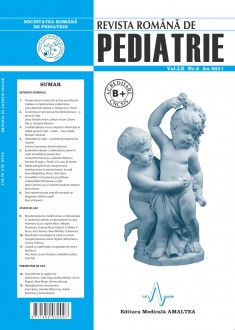SELECT ISSUE

Indexed

| |

|
|
|
| |
|
|
|

|
|
|
|
|
|
|
HIGHLIGHTS
National Awards “Science and Research”
NEW! RJP has announced the annually National Award for "Science and Research" for the best scientific articles published throughout the year in the official journal.
Read the Recommendations for the Conduct, Reporting, Editing, and Publication of Scholarly work in Medical Journals.
The published medical research literature is a global public good. Medical journal editors have a social responsibility to promote global health by publishing, whenever possible, research that furthers health worldwide.
Pathogenic pathways of drug therapy in child’s asthma
Maria Magdalena Florea and Stela Gotia
ABSTRACT
Asthmatic airways inflammation with still unknown various pathways involves multiple components and is orchestrated by numerous cell types, particularly mast cell, eosinophils, and CD4+ lymphocytes, but also airway structural cells. By there activation release over 100 pro-inflammatory mediators and cytokines, which in turn cause vascular leakage, bronchial smooth muscle contraction, inflammatory cell infiltration, mucus hypersecretion, airway hyper-responsiveness (AHR), and not ultimately airway remodeling. These changes are expressed clinically as recurrent wheezing, dyspnea, chest tightness and cough, which are typically associated with reversible airflow obstruction. Inhaled corticosteroids (ICS) are recommended as first-line treatment of persistent disease, but not all patients achieve asthma control even with high doses ICS or in combination with other medications, including a long acting β2 agonist or a leukotriene modifier. Such patients may require additional therapy. Last years, as we progress in knowledge asthma physiopathology, several novel anti-inflammatory therapies are in different stages of clinical development. The most clinically advanced of these is Omalizumabul (IgE antibody). Other key therapies options in clinical development either target pro-inflammatory cytokines or inflammatory cells.
Key words: allergic inflammation, asthma, anti-inflammatory treatment, biological alternative therapy
